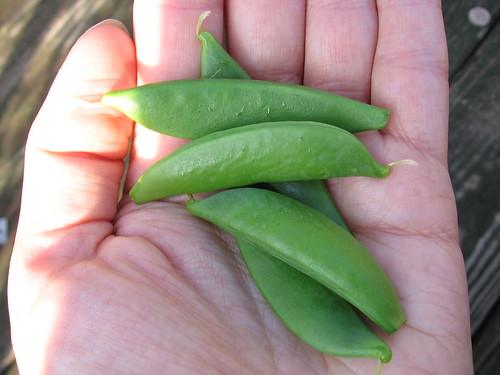Cropedia:Sugar Snap Peas
Sugar Snap Peas
" "
"
Source: http://www.flickr.com/photos/19209272@N00/2564699841/
Scientific name: Pisum sativum var. macrocarpon
Classification: sugar snap peas are a cross between snow peas and garden peas. [7] They are classified in the edible podded peas cultivar group, which means their pods are edible and lack a stiff paper-like inner lining. [6] Sugar snap peas contain sugary seeds, have a slightly thicker wall and their pods are round. [6]
Years grown at UBC Farm/LFSOG: 10 years on/off
Growing conditions
The growing conditions for sugar snap peas are listed below:
- Soil: should be well-drained, high in organic matter, pH 6.0 – 7.0. [2]
- Sunlight: full sun exposure or with partial shade. (Sugar snap peas yield best in full sun exposure.) [2]
- Temperature: peas grow best between 13-18 degrees Celsius [6]
- Water: keep soil moist. Avoid heavy watering during flowering as it may interfere with pollination. Water early in the day to allow the parts aboveground to dry quickly. This helps avoid plant diseases such as powdery mildew. [2]
- Planting: plant seeds 1-2 inches deep with 1-4 inches apart in rows that are 18 inches apart. [2] When the soil is cool and wet, shallow planting is best. [2] If the soil is dry, consider planting deeper into the ground. [2] Plant seeds in spring, as soon as soil is dry enough to till without sticking to gardening tools. [8] If planting in late spring and summer, pea seeds soaked for approximately an hour will help with growth in dry soil. [8] Note that sugar snap peas will require a trellis for support due to vining habits. [2]
- Harvest: Sprouting occurs 6-14 days depending on soil conditions and temperature. [2] The pods matures to open pollinate seeds in 115 days. [8] Pods are picked when they look pumped and bright green in color. [8] Sugar snap peas should be picked every 1-3 days for best quality. [7] Sugar snap peas are at their best before the seeds grow very big and when they first begin to look slightly flattened. [7] If they are left too long on the plant, the pod will begin to develop tough fibers in the wall, then they must be shelled, the pod discarded and only the pea inside may be consumed. [7]
Seasonality
Sugar snap peas grow best in warm seasons, which include mid-spring, late spring, early summer, mid-summer. [2] Note that sugar snap peas prefer cool, damp weather. [8]
Nutritional Information
| Nutrition Facts/Valeur Nutritive | |
|---|---|
| Serving Size: 98g (1 cup, chopped) | |
| Amount Per Serving | %Daily Value* |
| Calories 41 | |
| Total Fat 0g | 0% |
| Saturated Fat 0g | 0% |
| Trans Fat 0g | |
| Cholesterol 0mg | 0% |
| Sodium 0mg | 0% |
| Total Carbohydrate 7g | 2% |
| Dietary Fiber | 10% |
| Sugars 4g | |
| Protein 3g | |
| Vitamine A | 22% |
| Vitamine C | 98% |
| Calcium | 4% |
| Iron | 12% |
| * % Daily value based on a 2000 calorie diet | |
Information based on Canadian Nutrient File [1][4]
Recipes
Recipes and other culinary uses can be found below:
Vegetarian Option:
Additional usage inventory
Storage
- Fresh peas are best consumed/served shortly after they are harvested and consumed on the day of purchase. [3] If fresh peas are not consumed right away, they should be refrigerated because approximately half of the sugar content will turn into starch within 6 hours if kept at room temperature. [3] Fresh peas can be kept in the refrigerator for 2 to 3 days. [7] Do not wash the peas prior to storage and when storing in the refrigerator - they should be kept in a perforated plastic bag. [3]
Selection
- Sugar snap peas should be bright green in color, pump and firm. A few things to look for when selecting peas include the firm and glossy appearance with a slight velvety feel. [3]
Preparation
- Sugar snap peas should be rinsed prior to consumption. For a better mouth feel, the strings on the pods should be removed prior to cooking or eating. The strings run along the sides of the pod and can be easily removed by pulling upwards from the bottom tip. [3]
Academic connections
The foundation of the study of genetics was formed by Gregor Johann Mendel (Jul 20, 1822 – January 6, 1884) with his experiment with the inheritance of certain traits in pea plants. [5]
References
- 1. Canadian Food Inspection Agency. (2010). Canadian food inspection agency. Retrieved from http://www.inspection.gc.ca/english/toce.shtml
- 2. Cornell University. (2006) Vegetable Growing Guides – Peas. Retrieved February 23 2010 from http://www.gardening.cornell.edu/homegardening/scene9697.html
- 3. Fruits & Veggies Matter, . (2010).Vegetable of the Month: Peas. Retrieved from http://www.fruitsandveggiesmatter.gov/month/peas.html
- 4. Health Canada. (2010). Nutrient data. Retrieved from http://www.hc-sc.gc.ca/fn-an/nutrition/fiche-nutri-data/index-eng.php
- 5. Mendel, G. (1865). Experiments in plant hybridization (Translated). Retrieved from http://www.esp.org/foundations/genetics/classical/gm-65.pdfNutritionData.
- 6. Tsao, S.J. & Lo, H,F. (2003) Chapter 1 Vegetables: types and biology. In Handbook of vegetable preservation and processing. Retrieved April 3 2010 from CRCnetbase: www.crcnetbase.com
- 7. University of Illinois Extension. (2010) Watch your garden grow – peas. Retrieved February 23 2010 from http://urbanext.illinois.edu/veggies/peas1.html
- 8. West Coast Seeds. (2010) Super sugar snap. Retrieved April 3 2010 from http://www.westcoastseeds.com/productdetail/Vegetable-Seeds/Peas/Super-Sugar-Snap/